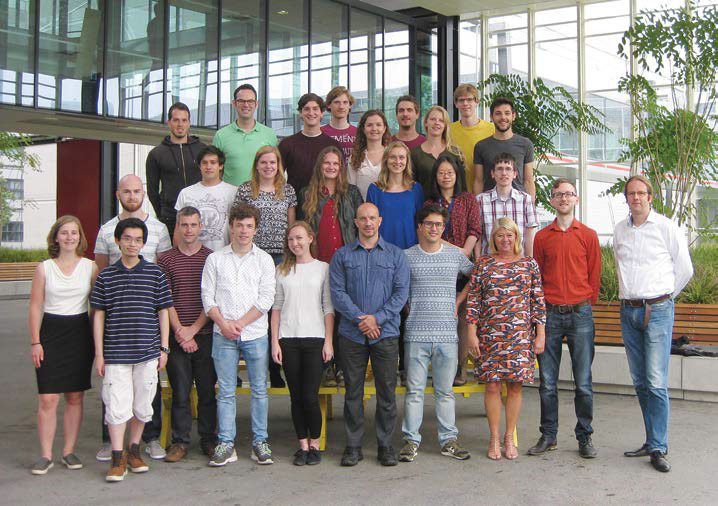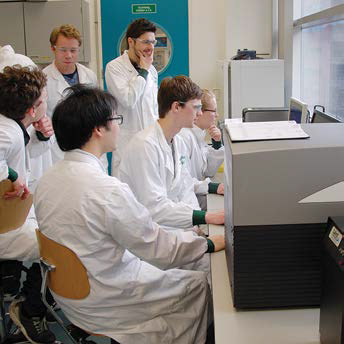Tecan uses cookies to improve our website. By continuing to browse our website, you accept our cookie policy.
Tecan uses cookies to improve our website. By continuing to browse our website, you accept our cookie policy.

Multidisciplinary research calls for multifunctional laboratory equipment capable of rapidly switching between applications. Staff in the Department of Biomedical Engineering at the TU Eindhoven understand that having the right instruments for your workflow can allow more users to benefit and help to accelerate research.

Biomedical engineering is a broad field, with scientists from numerous disciplines coming together to develop innovative solutions to challenges in the pharmaceutical, diagnostic and healthcare sectors. The Chemical Biology Group in Eindhoven University of Technology’s Department of Biomedical Engineering is even more diverse than most, as it was formed by merging together three existing research groups. The laboratory is now home to over 120 researchers, with a wide range of research interests. Anniek den Hamer, a PhD student in the group, explained: “We’re a big lab with a lot people – not just PhD students and postdocs, but also undergraduate and masters students – working on diff erent biotechnologies and applications; everything from protein-protein interactions and antibody-based sensors to DNA-based reaction networks, nuclear receptors and supramolecular architectures. It’s a very busy environment.”
This multidisciplinary team requires laboratory equipment that is equally versatile, enabling a wide range of activities to be performed quickly and easily. “All our instruments need to be both robust and fl exible,” Anniek continued. “We have had two Tecan multimode readers – a Safire2™ and an Infi nite® F500 – in the laboratory since the group was created, and perform a variety of measurements, including absorbance, fl uorescence intensity, fl uorescence polarization and bioluminescence. We have always been very happy with the reliability and performance of these instruments – despite the age of our Safi re2 reader – but the growing number of bioluminescence studies we are now performing, as well as an increase in students in the lab, means that we had eff ectively run out of instrument capacity. We looked at the various systems on the market, and the Spark® was an excellent match for our needs. The ability to switch between filter- and monochromator-based measurements is ideal for a multidisciplinary group, and the Spark’s bioluminescence module has a 40 fi lter set that enables you to perform complete luminescence scans, which is a huge advantage for assay development. Having all three readers from the same manufacturer also simplifi es staff training and equipment maintenance.”
“One of the biggest advantages for our lab is the system’s Te-Cool™ option, which was launched just before we purchased our Spark reader. Because we’re such a big lab, our readers are in high demand and constant use. Being able to accurately set the assay temperature and actively cool the measurement chamber is therefore a real boost to our productivity. For example, one user’s assay may require the measurement temperature to be fi xed at 37 °C, while the next user may want to perform an experiment at 20 °C. Previously, this could lead to long delays while waiting for the reader to cool and equilibrate to the correct temperature, with this time eff ectively ‘lost’. To speed up this process for our Infi nite and Safi re readers, we have resorted to opening the measurement chamber and using a fan to accelerate cooling, but this is far from ideal, and is
not particularly eff ective on a warm day. This issue is completely eliminated by the Spark’s Te-Cool module. You simply set it to the temperature you want, and it quickly and effi ciently heats or cools the measurement chamber to the target value. This saves a huge amount of time, and allows us to perform more experiments on any given day.” “The SparkControl™ software is also very intuitive to use. Anyone who has experience with the Infi nite’s iControl™ software can use the new system with virtually no training, and it’s very easy to explain to new users, which is particularly useful for teaching undergraduate or masters students with limited lab experience. Each user can also save and share their individual protocols – which saves a lot of time when switching between measurement modes or assay types – and if we have any queries, the Tecan helpdesk is always very quick to respond. Overall, we’re very pleased with the Spark system and the Te-Cool module, it’s proving to be a very versatile instrument.”

The Spark reader was purchased to help cope with the lab’s increasing number of students

The lab’s Safi re2 reader has performed reliably for many years
To find out more about Tecan’s Spark multimode reader, visit www.tecan.com/spark
To learn more about TU Eindhoven’s Department of Biomedical Engineering, go to www.tue.nl/en/university/ departments/biomedicalengineering/
Keywords: